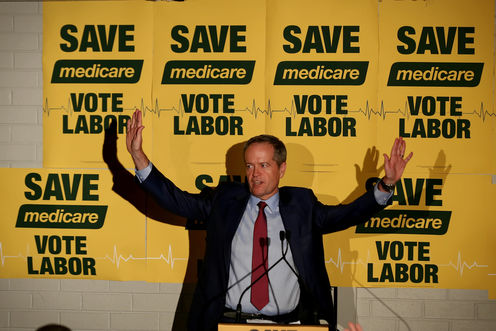
In a historical context, Labor’s ‘Medicare SMS’ was not particularly surprising or even unprecedented. AAP/Alex Ellinghausen
Labor’s Medicare SMS, texted to voters in the dying hours of the election campaign, has become famous for all the wrong reasons. Prime Minister Malcolm Turnbull called it “an extraordinary act of dishonesty” that the police should investigate. Health Minister Sussan Ley said it was “desperate and deceitful”.
It’s far from clear what law, if any, may have been broken by the Queensland Labor branch that sent the text. There’s nothing in the Commonwealth Electoral Act that outlaws dishonesty or deceit in campaign advertising, let alone desperation.
The SMS is cynical and unattractive but it is not, in a historical context, particularly surprising. The idea of hitting voters with a powerful message on election day is just the culmination of three trends in Australian campaign communication that have been brewing for decades.
Sidestepping the ‘blackout’
First, think of how the major political parties have progressively eroded and sidestepped the so-called “blackout” on election advertising.
Since 1942, radio and TV stations have been banned from broadcasting paid political ads during the last three days of the election campaign. The original idea was to provide voters with a space for calm deliberation before casting their vote.
Specifically, it was designed to prevent the last-minute broadcast of smears and allegations that could not be answered before election day – an indication of the prevailing fear about the broad reach and emotive impact of electronic advertising.
But as a piece of legislative effectiveness, it was always a few clauses short of watertight. It applied only to broadcasters, not newspaper publishers. Technological change steadily eroded any deliberative space it created.
Party campaign managers have creatively used non-broadcast forms of advertising to get their final campaign messages across. Billboard advertising, robocalls and YouTube channels continue right up to election day; digital teams in campaign HQ keep up the stream of emails, tweets and Facebook shares.
At the same time, parties have been increasing their face-to-face efforts to influence voters up to and on election day. The Australian Election Study shows there has been a steady increase in the number of undecided voters during a campaign; many only make up their minds on voting day itself.
Parties respond with corflutes, T-shirts and how-to-vote cards. In language adapted from commercial marketing, this is “point-of-sale” marketing, designed to give undecided voters a final nudge.
Targeting individuals
The second significant trend in campaign communication has been the increasing ability of parties to target advertising at small clusters of identified voters and, increasingly, at individuals.
With the advent of direct mail in the 1980s, parties were first able to complement their blanket top-down television advertising with more responsive, bottom-up local campaigning.
But since the trade union movement’s Your Rights at Work campaign against WorkChoices, and inspired by the Obama campaigns of 2008 and 2012, it has re-emerged with a vengeance in the digital era, especially in Labor. Under the banner of “micro-targeting”, it’s all about concentrating the campaign’s resources on persuading the persuadable – which means first locating them.
As the Parakeelia issue revealed during the election campaign, both major parties are deeply invested in the project of assembling data bases and applying “voter-tracking software” to identify persuadable voters and target relevant messages to them.
Parties have access to electoral rolls, census data and phone lists, and add their own information gathered from, for example, people who sign online petitions and constituents who visit their MP’s office. These integrated data bases, granular and geolocated, power a lot of contemporary campaign tools, such as direct mail, robocalling and door-knocking.
Parties have also acquired lists of mobile phone numbers – the holy grail of database campaigning.
Legal protections
The third trend is that Australian campaign communication has received increasing protection from the law.
Australia experimented with “truth in advertising” legislation in the 1980s, partly in reaction against a Liberal Party newspaper ad in the last week of the 1980 campaign that notoriously claimed the Labor opposition would introduce a “wealth tax”.
But the legislation, which specifically outlawed untruthful and misleading ads, was abandoned in a hurry, as parties and politicians realised the “truth” of a political statement was, in a competitive democratic election, inherently contestable. Besides, which regulator would be willing or available, in real time during a tight election, to act as the truth police?
Since then, several High Court judgments have gone much further in positively identifying an implicit constitutional freedom of speech. Campaign managers can push the boundaries, confident their advertising will remain unfettered by the law.
Lessons for future
It is not yet clear how many voters received Labor’s election day text, or how many of them were persuaded to change their vote. But in the competitive winner-take-all environment of an Australian election campaign, blackout provisions have been sidestepped.
Election day advertising has been normalised. Sophisticated databases have been assembled to target individuals on their doorstep, in their Facebook account, and on their mobile phone. And persuasiveness, not strict truth, is the accepted practice.
In this context, the Medicare SMS is not a surprise. We should have seen it coming.
Stephen Mills does not work for, consult, own shares in or receive funding from any company or organisation that would benefit from this article, and has disclosed no relevant affiliations beyond the academic appointment above.
